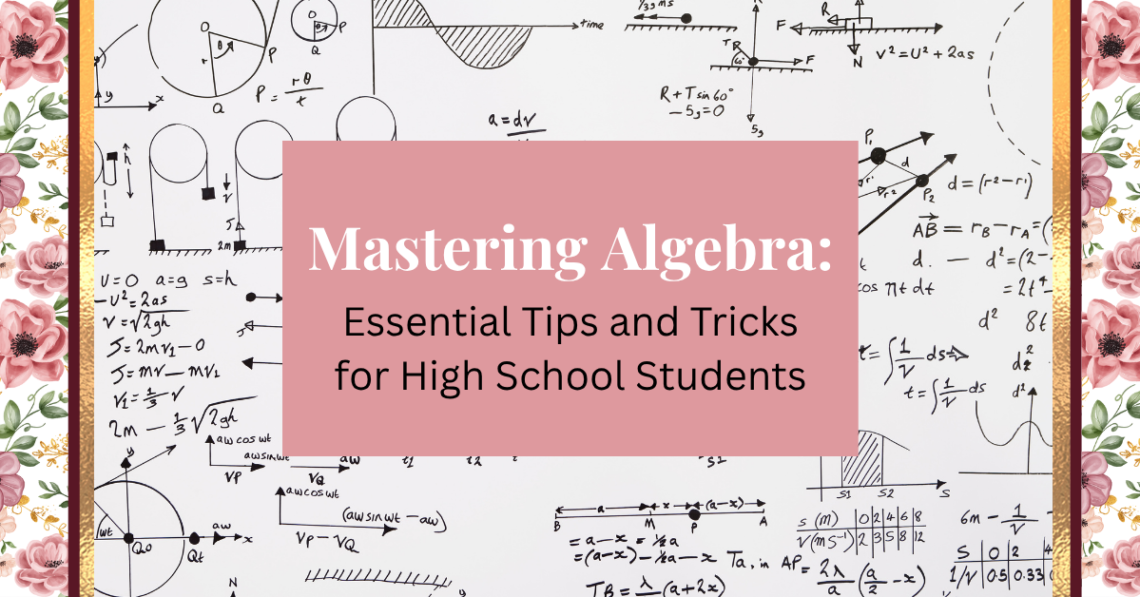Algebra can be one of the most challenging subjects for high school students, but it’s also one of the most essential. It forms the foundation for many advanced math topics and even plays a role in subjects like science, economics, and engineering. Fortunately, mastering algebra doesn’t have to be daunting. With the right strategies and mindset, students can not only succeed in algebra but also enjoy it. Here are some essential tips and tricks to help high school students conquer algebra and build confidence in their math abilities.
1. Understand the Basics Thoroughly
Before diving into complex equations, it’s crucial to have a strong grasp of the fundamentals. Algebra is built on simple concepts, and each new topic will build on what you’ve already learned. If you struggle with basic operations like addition, subtraction, multiplication, and division, it’s important to review these skills first.
Key Concepts to Master:
- Variables and Constants: Understand that variables represent unknown values and constants are fixed numbers.
- Operations with Variables: Get comfortable with combining like terms and applying the distributive property.
- Order of Operations (PEMDAS): Remember to follow the order of operations when solving expressions.
2. Practice Simplifying Expressions
Simplifying algebraic expressions is one of the first skills you’ll need to master. Start with basic expressions and gradually move to more complex ones.
Tip: Combine like terms (terms with the same variable raised to the same power). For example, simplify the expression:
\(3x+5x−2x\).
Answer: \(6x\)
The goal is to make the expression as simple as possible by adding or subtracting terms that are similar.
3. Master Solving Equations
One of the most fundamental tasks in algebra is solving equations. Whether it’s a linear equation, a quadratic equation, or a more complex system of equations, the process involves finding the value of the variable that makes the equation true.
Step-by-Step Approach to Solving Linear Equations:
- Isolate the variable on one side of the equation.
- Perform inverse operations to simplify (e.g., if the equation is \( x + 5 = 12\), subtract 5 from both sides to get \(x = 7\).
- Always check your solution by substituting it back into the original equation.
Example:
Solve for x:
\(3x−4=11\)
Add 4 to both sides: \(3x=15\)
Divide both sides by 3: \(x=5\)
Tip: Don’t rush! Take your time to ensure you’re isolating the variable correctly.
4. Work with Fractions Carefully
Fractions often appear in algebraic problems, and they can be tricky if you’re not comfortable with them. Make sure you understand how to add, subtract, multiply, and divide fractions before attempting algebra problems that include them.
Key Tips for Fractions in Algebra:
- Multiplying and Dividing Fractions: Multiply the numerators together and the denominators together. For division, multiply by the reciprocal.
- Adding and Subtracting Fractions: Find a common denominator before adding or subtracting the numerators.
Example:
To solve \( \frac{1}{2} + \frac{3}{4}\), find a common denominator (4), and then add the fractions:
\(\frac{1}{2} = \frac{2}{4}\),
So \(\frac{2}{4} + \frac{3}{4} = \frac{5}{4}\).
5. Use Graphing for Visual Understanding
Graphing is a powerful tool that allows you to visualize algebraic equations. It’s particularly useful for understanding linear equations, slopes, and intercepts. Plotting equations on a graph can help you better grasp the relationships between variables.
Key Concepts to Understand When Graphing:
- The Slope-Intercept Form of a Line: The equation \(y=mx+b\) represents a straight line, where m is the slope and b is the y-intercept.
- Plotting Points: Each point on the graph represents a solution to the equation. The x-coordinate is the value of the variable, and the y-coordinate is the result.
Example:
For the equation \( y=2x+3 \), the slope is 2, and the y-intercept is 3. This means the line crosses the y-axis at 3, and for every 1 unit increase in x, y increases by 2 units.
Tip: Use graphing calculators or online graphing tools (such as Desmos) to practice graphing equations and better visualize the relationships between variables.
6. Factorization Is Key to Solving Quadratic Equations
Quadratic equations often require factoring, and this is a critical skill in algebra. Factoring allows you to break down complex quadratic equations into simpler ones, making them easier to solve.
Basic Factoring Tips:
- For quadratics in the form \( ax^2+bx+c \), look for two numbers that multiply to ac and add to b.
- Use the distributive property (also known as the FOIL method) to expand binomials.
Example:
Factor the quadratic \( x^2 + 5x + 6 \).
Look for two numbers that multiply to 6 and add to 5. These numbers are 2 and 3, so the factored form is:
\((x+2)(x+3)\).
7. Apply Algebra to Word Problems
Word problems are often a daunting aspect of algebra, but they can be tackled systematically. Break the problem into smaller steps, and translate the words into mathematical expressions.
Steps to Solve Word Problems:
- Read the problem carefully and identify the variables.
- Translate the problem into an equation.
- Solve the equation using the methods you’ve learned (such as solving for the variable, factoring, or using the quadratic formula).
- Check your solution by plugging it back into the original problem.
Example:
If a train travels 60 miles per hour and you want to know how long it will take to travel 180 miles, you can set up the equation:
\( \text{time} = \frac{\text{distance}}{\text{rate}}\)
So, \(\text{time} = \frac{180}{60} = 3\) hours.
8. Practice, Practice, Practice
The most important tip for mastering algebra is practice. Algebra is a skill, and like any other skill, it requires consistent practice to improve. The more problems you solve, the more confident you’ll become. Try to challenge yourself with increasingly difficult problems and tackle a variety of topics.
Tip: Work on algebra problems every day, even if it’s just for 15-20 minutes. This consistent effort will pay off in the long run.
Conclusion
Algebra may seem challenging at first, but with the right strategies and practice, anyone can master it. By understanding the basics, practicing regularly, and applying problem-solving techniques, you’ll build a strong foundation that will serve you in future math courses and in many real-life situations. Remember, math is a skill, not a talent, and persistence is key. Keep practicing, and you’ll see your confidence and abilities grow!
What algebra topics do you find most challenging? Share your experiences and any helpful tips you have in the comments below! Let’s learn together.





